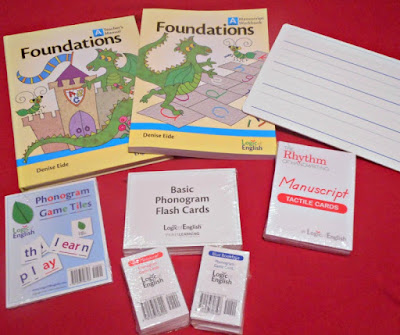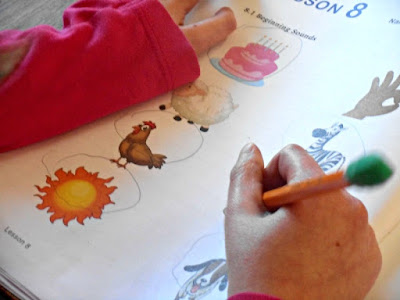Building a solid Foundation with Logic of English {Crew Review}
The Crew has reviewed Logic of English in the past but I've always hesitated about requesting to review Foundations Level A. It isn't that I didn't think it would be amazing. It's me. It's my daughter. She has skills all over the place and I wasn't sure that starting at the beginning of yet another homeschool reading curriculum would be in our best interest. I knew she wasn't really ready for Level B and since she hadn't used Foundations Level A, Foundations Level B wasn't really an option.
So why did I change my mind? Why did I decide that I did want to give this program a try even though it would mean starting at the beginning when she is already reading CVC and CCVC words? Why would would I want to start at the beginning when she already knows all the short vowel sounds and long vowel sounds and some phonograms like th, sh, ck, and ch? Because Foundations Level A is different.
I know that my daughter has asynchronous skills. I know that she struggles with forming certain sounds. I know she struggles with letter placement when forming her letters. I wanted to start with Foundations Level A because I want Supergirl to fill in the gaps in her skills and gain confidence in her budding ability to read fluently with comprehension.
The Pieces and Parts of Foundations Level A
I want to start with an overview of everything I received. Some of the items are specific to Foundations A and others are reusable and will be used throughout Foundations.
You will need these items:
- Foundations A Teacher Manual
- Foundations A Student Workbook
- Doodling Dragons: An ABC Book of Sounds
- Student Whiteboard
- Basic Phonogram Flash Cards
- Rhythm of Handwriting Tactile Cards
- Phonogram Game Cards
- Phonogram Game Tiles
- Phonogram and Spelling Rule Quick Reference
- Rhythm of Handwriting Quick Reference Chart
- Spelling Analysis Card
The Teacher Manual
This hardcover manual has over 200 pages! Foundations A has 40 lessons plus 8 Review/Assessment lessons. Denise Eide includes:
- Scope and Sequence ~ shows what skills are covered in Phonemic Awareness, Handwriting, and Spelling for each lesson.
- 2 page overview of the program
- Phonograms ~ one page chart of the sounds of the phonograms A through Z
- Materials Needed ~ this section lists out the materials needed and optional materials for each lesson
- Common Core Standards ~ the first section groups the standards into sections such as Kindergarten Reading Foundational Skills, and Kindergarten Reading Informational Texts. One column describes the standard and another column lists which lessons in Foundations those skills are covered. The second section lists out each lesson in Foundations A and which standards are covered.
- Fully Scripted Lessons ~ yes, Ms Eide even tells you what to say!
The Student Workbook
The paperback Student Workbook has perforated pages making them easy to tear out. The workbook includes handwriting practice pages, phonemic awareness, reading practice, games, and 6 student readers.
The student readers are located in the back of the workbook. The Teacher Manual will tell you when you need each reader.
Because the workbook includes handwriting practice pages, you need to choose your workbook based on manuscript or cursive. Instructions for both manuscript and cursive are included in the Teacher Manual.
The Anatomy of a Lesson
I thought the best way to describe how thorough this program is is to walk through a lesson. Each lesson has a blue box at the top that lists the objectives for that lesson and the Materials. Materials are divided into Needed and Optional. This box provides a nice overview of the lesson.
Every lesson begins with Phonemic Awareness. Sometimes the activities are listening for sounds. Sometimes the activities are blending sounds or words. Many lessons have an activity and a workbook page. Lesson 9, my sample lesson begins with a Beginning Sounds worksheet. The second activity is a Blending Treasure Hunt. The teacher segments a word, the student blends the segmented sounds into a word and then finds the object in the room.
Note: Supergirl had this to say about the program and phonemic awareness acivities. "It's fun but it's hard." She struggles with blending the words that have 4 or more sounds. This is another example of why I am loving my decision to start with Foundations A. She is getting extra practice with listening to longer words segmented and blending them together. This is an auditory processing and auditory memory skill. The more bits of information you can hold in your mind, the stronger your ability to process and retain the information. A longer auditory memory span is a foundational skill for more than just reading. An average adult has a digit span of least 7. A digit span of at least 4-5 is necessary for reading phonetically. What does that mean? It means that your brain can hold 4-5 chunks of information long enough to blend those sounds into words. If a child only has an auditory digit span of 2-3 she will struggle with blending longer 4 and 5 sound words such as stop or stomp. This is something that I have seen with Supergirl and I can not say enough positive things about how these phonemic awareness sections are helping to strengthen her skills.
After working on phonemic awareness skills, the lesson introduces a new phonogram. Unlike past programs that I have used, Logic of English teaches all the sounds of that phonogram. For the letter C you learn both /k/ and /s/ sounds.
I want to note that Denise Eide has a similar philosophy about teaching letter names. Knowing the name of the letter does not help a student learn how to read. Foundations A Teacher Manual instructs parent/teacher to refer to the phonogram by the sound(s) it represents and not by the letter name. I love that Supergirl is learning new sounds even though we're starting at the very beginning of a learn to read program. She's learning the third sound of a (as in Father) and learning both /g/ and /j/ for g.
The third section of a lesson is Handwriting. If a new phonogram has been introduced, then the handwriting lesson will focus on writing the phonogram. Earlier lessons begin by teaching the names of the lines: Top Line, Mid Line, Base Line. Basic strokes are taught first. I confess I was frustrated with trying to teach a stroke but now that we've mastered several strokes and a couple of phonograms that use those strokes, I see the logic in the Rhythm of Handwriting approach. I love that Supergirl is learning how to start at the mid-line roll to the base line swing to the mid-line and down to the base line to create the letter a. She's just learned the down swoop stroke this week and is applying it today in learning how to write g.
Starting with Lesson 9, a fourth section appears: Phonogram Practice. This section reviews past phonograms and builds fluency between the phonogram and the sounds. Some activities in the section help tie the written phonogram with the auditory sound it represents.
Two new sections are introduced in Lesson 21. Spelling and Reading. In these sections students are putting together the different skills they have learned. They start by reading and spelling words and then move on to reading phrases.
The program includes 8 Review Lessons which also allow the parent to assess the student's skills. They also provide an opportunity for additional practice. This is a mastery program and the Teacher Manual will tell which skills need to be mastered before you move on to the next set of lessons. Skills are ranked 1, 2, or 3. Skills that are ranked a 1 need to be mastered. The student should be familiar with skills ranked a 2 but they will be working extensively with those skills in upcoming lessons so it is not necessary that they be mastered at that review. Level 3 skills are in the chart but not included in the assessments. They are not necessary for becoming strong readers but may be beneficial for some students.
My Thoughts
This is a very thorough and fun program that is aptly named Foundations. The Teacher Manual is sprinkled with lots of little color coded boxes that offer Speech Tips, Challenge, Teacher Tips, Multi-sensory fun.
For kinesthetic learners and very wiggly-need-to-run-and-move young children this program offers lots physical movement. I found it easier to adapt for my daughter with physical challenges than I thought it would be.
I was confused about the pacing of the program. I did not see pacing addressed the teacher guide. I started out with dividing up each lesson by section and completing one lesson a week. We've now sped up a bit but I do take 2 days to do a lesson. This allows me to repeat the phonemic awareness sections for extra practice and still keep it fresh and new by adding in the handwriting. If she did not struggle so much with the phonemic awareness, I believe we could handle an average pace of a lesson per day. For now we'll continue our pace of 2-3 lessons per week so that she builds confidence and gains strength. I would love to see pacing suggestions listed in the Teacher Guide but I did find the FAQ on the website.
Because of the phonemic awareness sections, I highly recommend Foundations A. If you have older students ages 7 and up who struggle a bit with reading or spelling or whose skills could use some strengthening, check out the Essentials 2nd Edition program. Essentials also covers grammar. Many members of the Crew reviewed Essentials and some reviewed Foundations A, B, C or D. Click on the Banner to read more reviews of Logic of English.







I sure did appreciate all of those active sections. I think I have the wiggliest four year old in the world!
ReplyDelete